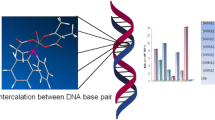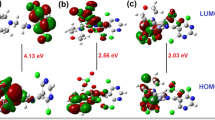Abstract
Five metal complexes of the third-generation quinolone antibacterial agent moxifloxacin with Cu(II), Fe(III), Mn(II), Ni(II) and VO(II) have been synthesized and characterized by physicochemical and spectroscopic techniques. In these complexes, moxifloxacin acts as a bidentate deprotonated ligand bound to the metal through ketone and carboxylate oxygens. The interactions between the metal complexes and calf thymus DNA have been studied by UV–Vis, circular dichroism and cyclic voltammetry. Fluorescence competitive binding studies with ethidium bromide (EB) demonstrate the ability of the complexes to displace the EB bound to DNA. The cytotoxicities of the complexes have been evaluated on A549 cells by the MTT (3-(4,5-dimethylthiazol-2-yl)-2,5-diphenyl-2H-tetrazolium bromide) method. [Cu(MFL)2(H2O)2] shows the highest anticancer potency. The apoptosis-inducing activity was assessed by acridine orange/ethidium bromide staining assay.









Similar content being viewed by others
References
Torramen U (1999) Apoptosis in non-small cell carcinolma and preinvasive lesions of lung, pp. 25. (Thesis). Available at: http://herkules.oulu.fi/isbn9514253302
Joseph B, Marchetti D, Formstecher P et al (2002) Oncogene 21:65–77
Herold C, Ocker M, Ganslmayer M, Gerauer H, Hahn EG, Schuppan D (2002) Br J Cancer 86:443
Sharma AK, Khosla R, Kelaand AK, Mehta VL (1994) Indian J Pharmacol 26:249
Anderson VE, Osheroff N (2001) Curr Pharm Des 7:337
Bromberg KD, Burgin AB, Osheroff N (2003) Biochemistry 42:3393
Aranha O, Grignon R, Fernandes N, McDonnell TJ, Wood DP, Sarkar FH (2003) J Oncol 22:787
Azema J, Guidetti B, Dewelle J, Le CB, Mijatovic T, Korolyov A, Vaysse J, Malet-Martino M, Martino R, Kiss R (2009) Bioorg Med Chem 17:5396
Yamakuchi M, Nakata M, Kawahara K, Kitajima I, Maruyama I (1997) Cancer Lett 119:213
Robles J, Martin-Polo J, Varez-Valtierra L, Hinojosa L, Mendoza-Diaz G (2000) Met Based Drugs 7:301
Turel I (2002) Coord Chem Rev 232:27–47
Wagman AS, Wentland MP (2007). In: Tayler JB, Triggle DJ (eds) Comprehensive Medicinal Chemistry II, vol 7, pp 567–596, Elsevier, Amsterdam
Andriole T (ed) (2000) The Quinolones, 3rd edn. Academic Press, San Diego
Heck MMS, Earnshaw WC (1986) J Cell Biol 103:2569–2581
Robles J, Martin-Polo J, Varez-Valtierra L, Hinojosa L, Mendoza-Diaz G (2000) Met Based Drugs 7:301
Nakamoto K (1986) infrared and raman spectra of inorganic and coordination compounds, 4th edn. Wiley, New York
Amin SS, Cryer K, Zhang B, Dutta SK, Eaton SS, Anderson OP, Miller SM, Reul BA, Brichard SM, Crans DC (2000) Inorg Chem 39:406–416
Skyrianou KC, Efthimiadou EK, Psycharis V, Terzis A, Kessissoglou DP, Psomas G (2009) J Inorg Biochem 104:1617–1625
Sacconi L, Mani F, Bencini A (1989). In: Wilkinson G (ed) Comprehensive coordination chemistry, vol 5, pp 1–347. Pergamon Press, Oxford
Skyrianou KC, Raptopoulou CP, Psycharis V, Kessissoglou DP, Psomas G (2009) Polyhedron 28:3265–3271
Smith TS, LoBrutto R, Pecoraro VL (2002) Coord Chem Rev 228:1–18
Tolis EJ, Teberekidis VI, Raptopoulou CP, Terzis A, Sigalas MP, Deligiannakis Y, Kabanos TA (2001) Chem Eur J 7:2698–2710
Jain MC, Srivastava AK, Jain PC (1977) Inorg Chim Acta 23:199
Psomas G (2008) J Inorg Biochem 102:1798–1811
Bandwar RP, Rao CP (1997) J Inorg Biochem 68:1–6
Saha DK, Padhye S (2005) Transition metal chemistry 30:334–340
Krivis AF, Rabb MR (1996) Nature 7:1064
Thirumavalavan M, Akilan P, Kandaswamy M (2005) Polyhedron 24:1781–1791
Zhang S, Niu S, Qu B, Jie G, Xu H, Ding C (2005) J Inorg Biochem 99:2340–2347
Pyle AM, Rehman JP, Meshoyrer R, Kumar CV, Turro NJ, Barton JK (1989) J Am Chem Soc 111:3053–3063
Efthimiadou K, Karaliota A, Psomas G (2010) J Inorg Biochem 104:455–466
Chauhan M, Banerjee K, Arjmand F (2007) J Inorg Chem 46:3072–3082
Carter MT, Bard AJ (1987) J Am Chem Soc 109:7528–7530
Skyrianou CK, Efthimiadou EK, Psycharis V, Terzis A, Kessissoglou DP, Psomas G (2009) J Inorg Biochem 103:1617–1625
Uma Maheswari P, Palaniandavar M (2004) J Inorg Biochem 98:219
Norden B, Tjerneld F (1982) Biopolymers 21:1713
Thounaojam MC, Jadeja RN, Valodkar M, Nagar PS, Devkar RV, Thakore S (2011) Food Chem Toxicol 49(11):2990–2996
Baskic D, Popovic S, Ristic P, Arsenijevic NN (2006) Cell Biol Int 30(11):942
Acknowledgments
The authors are thankful to University Grants Commission, New Delhi for financial support and are grateful to Head, Dept of Chemistry and Dept of Zoology for providing laboratory facilities. The award of INSPIRE (DST-NEW DELHI) Fellowship to Rinky Singh is also gratefully acknowledged.
Author information
Authors and Affiliations
Corresponding author
Electronic supplementary material
Below is the link to the electronic supplementary material.
Rights and permissions
About this article
Cite this article
Singh, R., Jadeja, R.N., Thounaojam, M.C. et al. Synthesis, characterization, DNA binding and cytotoxicity studies of moxifloxacinato complexes. Transition Met Chem 37, 541–551 (2012). https://doi.org/10.1007/s11243-012-9620-5
Received:
Accepted:
Published:
Issue Date:
DOI: https://doi.org/10.1007/s11243-012-9620-5




